Home » Technical Program » Organic and Perovskite Electronics
Organic and Perovskite Electronics
Organic and organometal-halide perovskite materials have emerged in recent years as important alternatives to traditional inorganic materials for optoelectronic devices. These novel materials provide huge potential benefits such as reduced-cost processing, compatibility with nonconforming and flexible substrates, and tunable color properties, allowing for a range of interesting applications. Organic light-emitting diodes (OLEDs) have become widespread commercially in displays, with improvements in brightness and contrast ratios, as well as interesting form factors such as thin and flexible devices. Perovskite-based photovoltaic devices are attracting considerable interest as a potentially disruptive energy technology, with power conversion efficiencies similar or in excess of those seen in current panels but with simpler processing requirements.
Like any interesting and fast-growing field of technology, the achievements, and benefits in the field of organic/organometallic electronics and optoelectronics don’t come without their own challenges. The inherent properties of these materials make them challenging to deposit using a vapor-phase technology:
- The materials are typically prone to decomposition at relatively lower temperatures which has led to development and use of evaporation sources with complex set of features and temperature control mechanisms.
- Additionally, some of the active films in the device architecture require precise rate control algorithms to achieve the required host-dopant compositions, which in turn also require critical hardware considerations.
- Materials are mostly sensitive to moisture and oxygen, so the protection from these elements during and post-fabrication is critical.
These factors require a deep understanding of material properties, study and treatment of substrates and interfacial properties of layers, considerations of the bottlenecks towards device fabrication, encapsulation techniques and thin-film deposition system solutions, and combined they result in an exciting process in this field of study.
This session welcomes papers addressing materials and processing challenges related to these technologies involving vacuum and vapor-based techniques such as evaporation, sputtering and ALD. We encourage submissions on practical approach towards fabrication of organic devices and emphasizing on key parameters to consider during the design and building steps. Discussion on challenges and opportunities in scaling up processes for industrial production will be integral to the symposium.
The session will include discussions on research on the following device types:
- Organic and perovskite light-emitting diodes (OLEDs & PLEDs),
- Organic and perovskite photovoltaics (OPV & perovskite PV),
- Hybrid inorganic/perovskite tandem photovoltaics,
- Organic thin-film transistors (OTFTs & OFETs),
- Organic memory devices and spintronics,
- Organic sensors,
- Flexible and wearable electronics, and
- Building-integrated Photovoltaics (BIPV).
Organic and Perovskite Electronics TAC Co-Chairs: Mike Miller, Angstrom Engineering, mmiller@angstromengineering.com; John Naylor, Kurt J. Lesker Company, johnn@lesker.com; Paul Sullivan, Kurt J. Lesker Company, paulsu@lesker.com; Akhil Vohra, Angstrom Engineering, avohra@angstromengineering.com

